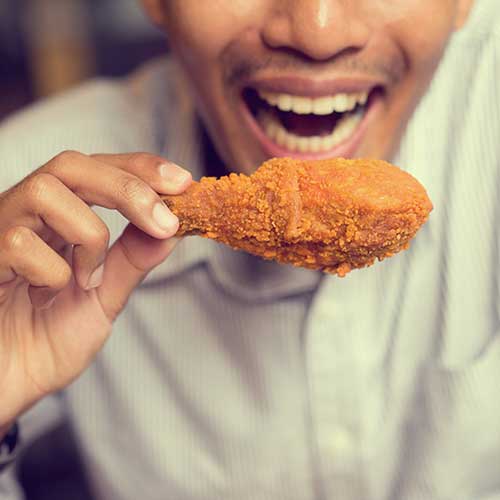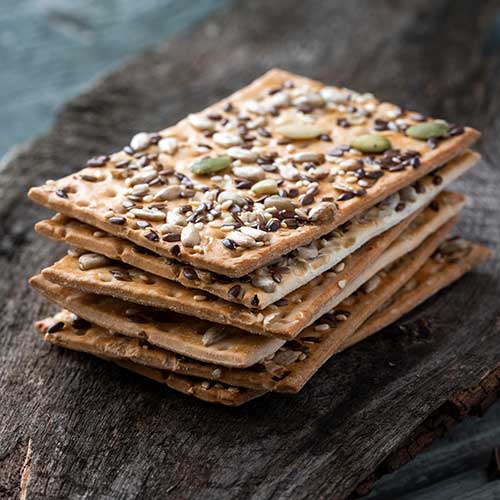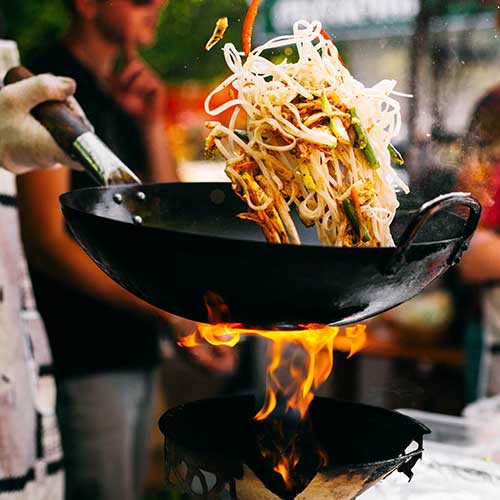best phrase to describe whats in the start menu
73 Words & Adjectives to Describe Food
Last updated on ii/xi/2020
When it comes to writing a card, give-and-take choice is critical. Although menu pricing is of import, the words yous use to draw your food and how y'all make your carte du jour could entice customers and increase sales if properly chosen. Conversely, a poorly written menu can turn customers off or confuse them if y'all're not careful. Beneath, we break downwards the key components to menu writing and offering a list of descriptive words for food to go you started.
Words to Draw Taste

The flavor of your nutrient is what most customers focus on when they are deciding what to swallow. The way you engineer your menu tin can help build anticipation, and a good bill of fare clarification could even convince a hesitant client to endeavor something new. With this in mind, it'southward important to be precise and thorough when choosing words to describe your food's flavour.
Here are some words that are commonly used to describe food:
- Acidic: A food with a sharp sense of taste. Often used to refer to tart or sour foods as well.
- Bitter: A tart, abrupt, and sometimes harsh flavor.
- Bittersweet: A less harsh sense of taste than bitterness. Couples tartness with sugariness.
- Briny: Another give-and-take for salty.
- Citrusy: A bright flavour like that of lemons, limes, oranges, and other citrus fruits.
- Cooling: A sense of taste that mimics the feeling of cold temperature. Often used to describe mint.
- Earthy: Reminiscent of fresh soil. Often used to describe red wines, root vegetables, and mushrooms.
- Peppery: A gustatory modality that feels as though it gives off estrus. Another word for spicy.
- Fresh: A lite and crisp gustation. Ofttimes used to describe produce or herbs.
- Fruity: Whatever gustation reminiscent of sweet fruit flavors.
- Concentrated: Rich season that can feel heavy in the mouth. Oftentimes used to describe wines.
- Herbal: A bright, fresh, or sometimes earthy taste created by the incorporation of herbs.
- Honeyed: A sweet or candied gustation that may be reminiscent of honey.
- Nutty: Any taste like to the flavors of nuts. Often used to describe cheeses.
- Rich: A total, heavy flavor. Frequently used to describe foods containing cream.
- Robust: A rich taste with some earthiness. Often used to describe wines or aged liquors.
- Abrupt: A harsh, bitter, or tart sense of taste. Often used to describe acidic foods.
- Smoky: A smoky taste is reminiscent of the odor of smoke.
- Sour: A biting, tangy, tart flavor.
- Spicy: A called-for sense of taste from hot spices.
- Sweet: A sugary flavor.
- Tangy: A tart, biting sense of taste that feels tingly in the mouth.
- Tart: A sharp, biting, or sour season. Often used to describe acidic foods.
- Yeasty: An earthy sense of taste reminiscent of yeast. Often used to describe beer and breads.
- Woody: An earthy, sometimes nutty taste. Often used to depict coffees or cheeses.
- Zesty: A fresh, vivid, or invigorating season.
Words to Describe Texture

Some other consideration when describing your food is texture. Properly using food adjectives to draw mouthfeel helps your guests to imagine what it will exist like to eat your food before they order information technology.
Here are some words that are commonly used to depict texture:
- Airy: A light, pillowy texture often created past the incorporation of air.
- Buttery: A shine and creamy texture similar to that of butter.
- Chewy: The texture of a nutrient that needs to exist chewed thoroughly earlier swallowing. Tin be calorie-free and bouncy or heavy and sticky.
- Creamy: A smooth and rich texture that usually comes from the incorporation of dairy.
- Crispy: A light texture with a slight crisis.
- Crumbly: The texture of a food with a loose structure that falls apart into pocket-sized pieces or crumbs.
- Crunchy: A business firm, well-baked texture ofttimes identified by the abrupt, aural noise that the nutrient makes when existence eaten.
- Crusty: The texture of a food with a hard outer layer and soft interior.
- Delicate: A light, fine texture that may come apart easily.
- Doughy: A soft and heavy texture that is frequently coupled with pale coloring.
- Fizzy: A texture brought on by the presence of many small bubbles, usually referring to carbonated liquids.
- Flaky: A calorie-free texture characterized by layers that come autonomously during eating.
- Fluffy: A light and airy texture.
- Gooey: A viscous, sometimes gluey texture arising from the presence of moisture in a dense solid food.
- Hearty: A house, robust texture.
- Juicy: A succulent, tender texture characterized past the presence of liquid in a solid food.
- Silky: A fine, shine texture characterized by a sleek feel in the oral fissure.
- Sticky: A texture characterized by gluiness in the oral fissure.
- Smooth: A consistent texture free of grit, lumps, or indentations.
- Succulent: A tender, juicy texture.
- Tender: A soft texture that is easy to pause downwards.
- Velvety: A smooth and rich texture.
- Baked: A food that was cooked in an oven, often resulting in a crispy outer blanket.
- Blanched: A food that was scalded in boiling water and so moved to common cold h2o to stop cooking. Results in a softened texture.
- Blackened: A food that was dipped in butter and coated with spices before being cooked in a hot pan, resulting in a blackened appearance.
- Braised: Food that is briefly fried in a small amount of fat so is slowly stewed in a covered pot. Results in a seared, crispy outside coupled with a tender interior texture.
- Breaded: A breaded food is one that was coated with a breadcrumb mixture or batter that is then broiled or fried into a crispy outer layer.
- Broiled: A food cooked with intense radiant estrus, as in an oven or on a grill. Often results in a darkened appearance and crispy texture.
- Caramelized: A caramelized food is one that has been cooked slowly until it is browned and becomes sweeter in taste.
- Charred: Food that is grilled, roasted, or broiled and gains a blackened exterior coupled with a smoky flavor.
- Fermented: A food that has been introduced to leaner, yeast, or another microorganism to produce organic acids, alcohols, or gases. May result in a pungent, biting flavor.
- Fried: Nutrient that is cooked by submerging partially or fully into hot oil. Often results in a crispy or crunchy texture and gilt color.
- Glazed: A food that becomes moistened by having a flavorful coating dripped or brushed onto its surface. May result in a glossy appearance and sparse, crisp outer layer.
- Infused: A food that has been steeped in liquid with some other ingredient in order to excerpt the flavor of the ingredient. Oftentimes used with herbs.
- Marinated: A food (normally meat) that has been soaked in liquid containing flavorful ingredients like herbs, spices, vinegar, and oil.
- Poached: Food that has been cooked in well-nigh boiling liquid. Often results in a tender, moist texture.
- Roasted: Nutrient that has been cooked with dry heat in an oven or over a fire. Often results in a browned outside and well-baked blanket.
- Sauteed: A nutrient that has been cooked quickly in a small-scale amount of fatty.
- Seared: A food that is cooked in a small-scale corporeality of fat until caramelized and then finished by roasting, grilling, or another method. Results in a well-baked outer texture and tender interior.
- Smoked: Smoked food is nutrient that is cooked or preserved by long exposure to smoke from smoldering forest. Results in a distinctive, bold flavor.
- Whipped: Food that has been beaten to contain air. Often results in a lite, fluffy texture.
- Dry out vs. crispy: Chicken with a dry out breading compared to Craven with a crispy breading
- Greasy vs. velvety: Pasta in a greasy sauce compared to Pasta in a velvety sauce
- Sugary vs. honeyed: Pears with a sugary drizzle compared to Pears with a honeyed drizzle
- Burned vs. blackened: Burned salmon compared to Blackened salmon
- Tough vs. hearty: A piece of tough bread compared to A piece of hearty bread
- Mushy vs. tender: A mushy crabcakecompared to A tender crabcake
Words to Describe Nutrient Preparation Method

One of the all-time ways to depict food on your menu is past indicating how it was prepared. And so long equally your customer recognizes the words you lot choose, information technology volition give them a articulate picture of your food's flavor and appearance.
Hither are some words that indicate preparation and cooking method:
Positive Food Adjectives
The easiest way to accidentally influence your customers into passing over a menu particular is to use a word with a negative connotation. Before you put a word in your carte du jour description, take a moment to recall virtually how that word is commonly used. Does it bring a positive image to mind, or is it unappetizing? Additionally, the positive alternatives to negative words are often more than specific, so they requite your customers a more precise idea of what your food is like.
Here are some examples of negative describing words and the positive food adjectives that you can utilize to replace them:
When you're trying to find the right words to depict the food on your bill of fare, exist sure to explore the hundreds of options that you have. Think to use words that are appealing plenty to catch a customer'south eye, common plenty to explain your food at a glance, and specialized enough that y'all don't have to resort to cliches. Adjacent time you lot add a new dish or want to overhaul your menu, keep in mind that the time you lot invest in your card descriptions can help sell your food to customers.
Source: https://www.webstaurantstore.com/article/53/how-to-write-a-menu.html
0 Response to "best phrase to describe whats in the start menu"
Post a Comment